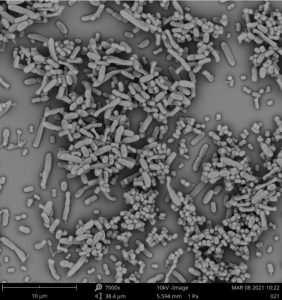Government
Drug-Resistant Bacterial Pathogens Collaborate to Boost Virulence
Some of the world’s most deadly and drug-resistant pathogens are known to work collaboratively to become more infectious. Now, for the first time, the…

The two opportunistic pathogens, Acinetobacter baumannii and Klebsiella pneumoniae, are frequently isolated together from polymicrobial infections. The infections that contain both bacteria can be more severe and recalcitrant to therapy when compared to infections caused by either species alone. Now, for the first time, the mutually beneficial relationship between K. pneumoniae and A. baumannii has been described.
Due to their high levels of drug resistance, the two pathogens are on the World Health Organization’s priority list for urgent need of new antibiotics. Studies in the United States and Europe have found them co-existing in about 40% of all hospitalized patients.

This new study outlines how Klebsiella feeds Acinetobacter through its metabolic by-products. In return, Acinetobacter protects Klebsiella from high concentrations of drugs through the secretion of antibiotic-degrading enzymes.
The work is published in Nature Communications in the article, “Cross-protection and cross-feeding between Klebsiella pneumoniae and Acinetobacter baumannii promotes their co-existence.”
The researchers characterized the genomes of A. baumannii and K. pneumoniae strains isolated from a human lung infection. In doing so, they could examine various aspects of their interactions through transcriptomic, phenomic, and phenotypic assays.
“This research is significant because diagnostic methods commonly look for the most dominant pathogen and therefore treatment is targeted at that,” said Lucie Semenec, PhD, a postdoctoral fellow in the School of Natural Sciences at Macquarie University in Sydney, Australia. “New drugs now can be informed in future research by the molecular mechanisms we find in this work.”
“We have found that they have a mutually beneficial relationship to one another that enables Klebsiella to survive in antibiotic concentrations significantly higher than it can on its own,” Semenec added.

More specifically, they found that K. pneumoniae cross-feeds A. baumannii by-products of sugar fermentation. In turn, A. baumannii cross-protects K. pneumoniae against the antibiotics cephalosporin and cefotaxime.
The in vivo infection studies were done using the Galleria mellonella (greater wax moth larvae) animal model alternative at the Macquarie Galleria Research Facility—the first of its kind in Australia.
The research, noted Amy Cain, PhD, associate professor of Macquarie University, highlights the pressing need for improved screening for mixed infections in hospital settings. “It’s important to understand that together these bugs are more infectious, more resistant to treatment and they feed off each other.”
The post Drug-Resistant Bacterial Pathogens Collaborate to Boost Virulence appeared first on GEN – Genetic Engineering and Biotechnology News.

Here Are the Champions! Our Top Performing Stories in 2023
It has been quite a year – not just for the psychedelic industry, but also for humanity as a whole. Volatile might not be the most elegant word for it,…
AI can already diagnose depression better than a doctor and tell you which treatment is best
Artificial intelligence (AI) shows great promise in revolutionizing the diagnosis and treatment of depression, offering more accurate diagnoses and predicting…
Scientists use organoid model to identify potential new pancreatic cancer treatment
A drug screening system that models cancers using lab-grown tissues called organoids has helped uncover a promising target for future pancreatic cancer…













